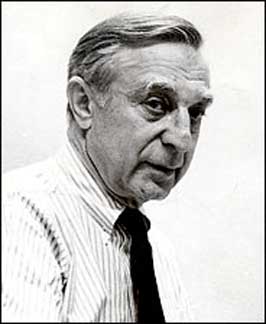
|
Reprint
Remembering the Work of Architect Max Abramovitz In a flurry of discontent felt towards the era of urban renewal in Buffalo, many people forget about the fine builders and architects that came out to revive the urban landscape after years of sprawl and problematic design. One of these names is of the architect, Max Abramovitz, who spent 41 years practicing in the firm of Harrison and Abramovitz, and is often considered as one of the finest architects in New York State and East Coast in general. His most famous works include the CIA Headquarters (Langley,1961), Westinghouse Building (Pittsburgh,1970), Corning Glass Building (Corning,1957), Rockefeller Center (New York City,1960), United Nations Headquarters (New York City,1966), and his most famous being the Avery Fisher Hall at the Lincoln Center (New York City,1962). In Buffalo, Abramovitz designed the Temple Beth Zion (1967) and the Erie County Savings Bank Tower (later renamed Main Place Tower (1969). Max Abramovitz was born in Chicago in 1908, graduating from both Illinois Urbana-Champaign and Columbia. After studying at the Ecole des Beaux-Arts in Paris, he was hired as an associate in the firm of Harrison & Fouilhoux in 1935. He rose to partner in the firm by 1941 and began working on larger scale buildings, while also teaching at Yale concurrently. After a brief stint in the Army Corps of Engineers during WWII, he came back to a building boom, particularly in New York. From 1947 until 1952, Abramovitz acted as Deputy Director of Planning at the United Nations Headquarters with head architects, Oscar Niemeyer and Le Corbusier. Abramovitz had a thorough education in the International Style of architecture, later branching out into other Mid-Century architectural styles. Through the 1960s, Abramovitz proved himself a competent designer on the national stage. In 1962, Abramovitz designed the Avery Fisher Hall, an integral part of the Lincoln Center in New York City. Accompanied by such heavy-hitters as Gordon Bunshaft, Wallace Harrison, Eero Saarinen, Pietro Belluschi, and Philip Johnson. So, when the earlier Temple Beth Zion was lost to fire in 1961, the congregation decided to have Max Abramovitz design their new home at 805 Delaware Avenue in the Modern Style. Max Abramovitz, as a practicing Jew, designed multiple other synagogues all over the northeast, including at Brandeis University (1955), Jewish Institute of Religion (1979), and at West Point (1984). He designed the synagogue in concrete with scalloped walls that symbolize the Ten Commandments. Abramovitz then pushed the walls open towards the street as to show arms interlocked in prayer. Although he was limited by a modest budget, Abramovitz still employed an impressive design that created a warm interior with help from a large skylight and a central stained-glass window. Abramovitz made a very cold material warm and hospitable in the Temple Beth Zion. Main Place Tower To show the versatility of Max Abramovitz, he later designed the very utilitarian Main Place Tower for the Erie County Savings Bank, after their earlier Shelton Square home was demolished in 1968. Now, please do separate the Main Place Mall from the Main Place Tower, as the mall was very shoddily designed by a Lathrop Douglass in an attempt at Urban Renewal. Often being compared to the Death Star in Star Wars, Abramovitz cladded his tower in a black steel, as he did in Pittsburgh’s Alcoa Building (1953) and US Steel Tower (1971). Max Abramovitz evolved past the International emphasis on glass-only cladding. In the Main Place Tower, the singular repeating design that was invented by the Internationalists was implemented with steel being the greatest part. The skyscraper, although arguably not the prettiest downtown, is an important part of the downtown architectural context. This is no more noticeable than between the Main Place and M&T Towers that appear next to each other and only separate by 3 years. The contributions that Max Abramovitz made in Buffalo, between the Temple Beth Zion and the Main Place Tower, are diverse and important features of the Modern style locally. |